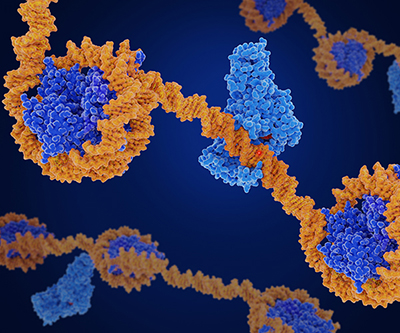
Molecular model of DNA (orange) wrapped around nucleosomes (purple).
Credit: stock image
Transcription refers to the process in which instructions in DNA are converted to messenger RNA, which can leave the cell’s nucleus to direct synthesis of its encoded protein. While scientists know the general steps and key factors involved in the initiation of transcription, there is still much to learn about how this process is coordinated.
The Hinnebusch Lab studies molecular mechanisms of gene regulation at the transcriptional level, using budding yeast as a model system. In a recent study, the lab clarified the roles of three chromatin remodelers—SWI/SNF, RSC, and Ino80C. Chromatin is densely coiled DNA that is wrapped around nucleosomes, often visualized as “beads on a string.” For transcription to occur, chromatin at the start site has to be unpacked and unwound by proteins like these three remodelers. The lab’s findings illuminate functional cooperation among these three remodelers in displacing nucleosomes from control regions upstream of genes induced by amino acid starvation, which helps facilitate binding of the activator protein and a key transcription factor needed to recruit an enzyme that synthesizes the messenger RNAs from the co-regulated genes.
Learn more about the Cell Regulation and Development Affinity Group:
https://www.nichd.nih.gov/about/org/dir/affinity-groups/CRD
 BACK TO TOP
BACK TO TOP